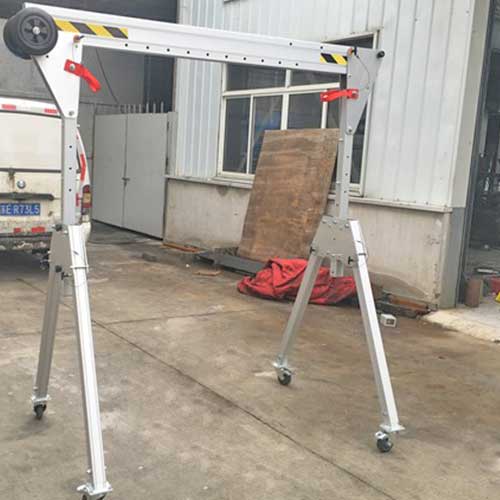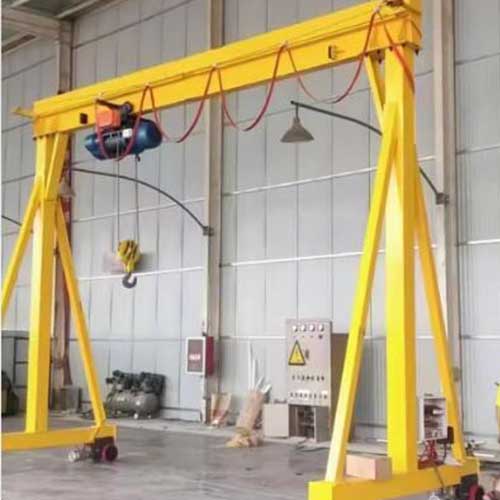Small A-Frame Cranes Buyer’s Guide: Find Ideal Crane
Learn how to choose the perfect 1 ton, 2 ton, 5 ton, or 10-ton A-frame crane for your lifting needs efficiently. Get small a frame crane at good price.
Category: A Frame Crane
Your Trusted A Frame Gantry Crane Manufacturer & Supplier
Small A-Frame Cranes for Sale 1 to 10 Ton Options
Small A-Frame Cranes Buyer's Guide: Find the Ideal 1, 2, 5, or 10 Ton Crane for Your Needs
Introduction: How to Choose the Right Small A-Frame Crane
If you're in the market for a small A-frame crane, you might already know these are simple, practical machines designed to lift light to medium loads. They're widely used because they're straightforward, easy to set up, and don't take up much space. Whether you need to move machinery in a workshop or lift equipment on a construction site, these cranes fit the bill.
But here's the catch: picking the right capacity—or tonnage—is crucial. Choosing a crane that's too small for your load puts your safety at risk and can cause unnecessary wear and tear on the equipment. On the other hand, buying a crane with way more capacity than you need means you're paying for power you won't use, and that can add up quickly.
Most buyers look at four main sizes: 1 ton, 2 ton, 5 ton, and 10 ton. These cover most needs from basic maintenance jobs to heavier industrial lifting. Knowing which size fits your specific tasks helps you avoid costly mistakes and keeps your work running smoothly.
Key points to consider:
- A-frame cranes are ideal for light to medium lifting tasks across many industries.
- Capacity directly affects safety, efficiency, and overall cost.
- The most common sizes—1, 2, 5, and 10 tons—serve different industries and workloads.
- Keywords to keep in mind: 1 ton a frame hoist, 2 ton a frame hoist, 2 ton a frame gantry, 5 ton a frame gantry, 5 ton a frame crane, 10 ton a frame hoist.
By understanding the basics here, you'll be ready to dig into the specific crane options that best fit your needs.
Types of Small A-Frame Cranes by Capacity
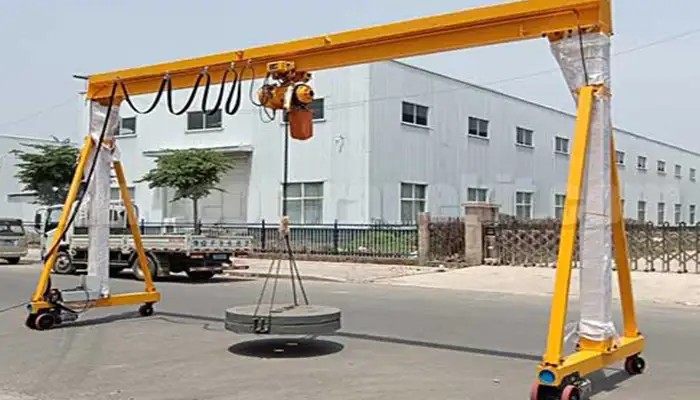
Small Steel A-Frame Gantry Cranes (0.5–5 Ton Typical, tailored up to 10 Ton )
Types:
- Fixed Height A Frame Crane: Rigid frame with a set height; ideal for repetitive lifting in consistent spaces.
- Adjustable Height A Frame Crane: Telescoping or bolted legs with manual or powered adjustment: Hand winch, Mechanical turbine gear,Electric actuator, etc.
- Manual TravellingA Frame Crane: Fitted with casters for hand-pushed mobility; best for loads under 2 tons.
- Electric Travelling A Frame Crane: Motorized wheels for powered movement; suitable for loads above 2 tons and frequent relocation.
Optional Features
- Height Adjustment: Pin-lock, screw jack, or electric lift
- Mobility: Swivel/locking casters, pneumatic wheels, or powered travel
- Span/Tread Options: Adjustable beam length or leg spacing
- Finish Options: Powder-coated, galvanized, or heat/weather-resistant
- Safety: Overload limiters, locking pins, safety chains, emergency stops
- Accessories: Manual/electric hoists, push/motorized trolleys, clamps, lifting beams
- Structure: Foldable/removable legs, reinforced frames, modular design
Let me know if you'd like this tailored into a product spec sheet or quick reference guide.
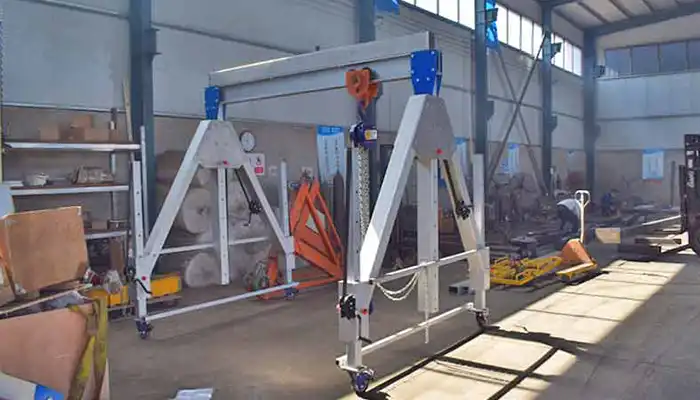
Small Aluminum A-Frame Gantry Cranes
- Fixed Height Aluminum A-Frame Crane: Lightweight with a set height for straightforward lifting tasks. Easy to operate and reliable for consistent jobs.
- Adjustable Height Aluminum A-Frame Crane: Features legs that can be adjusted to different heights, offering flexibility for various lifting requirements.
- Folding or Collapsible Aluminum A-Frame Crane: Designed for quick folding, making it highly portable and easy to store when not in use.
- Telescopic Span Aluminum A-Frame Crane: Allows adjustment of the leg spacing to handle loads of different widths comfortably.
- Freestanding Aluminum A-Frame Crane: Stable without the need for additional support, suitable for flexible setup locations.
Optional Features for Aluminum A Frame Gantry Cranes
- Motorized Trolley or Hoist (electric or manual)
- Wheels / Casters for easy mobility
- Brake System for secure positioning
- Load Limit Indicators for safety
- Custom Span and Height Dimensions
- Weather-Resistant Coating for outdoor use
- Chain or Wire Rope Hoists
- Adjustable Foot Pads for uneven surfaces
- Remote Control Operation for motorized models
- Safety Guards and Covers
Additional Customization Possibilities for Both Steel and Aluminum A-Frame Cranes
- Tailored load capacities beyond standard ranges.
- Multiple adjustment points for height and span flexibility.
- Special designs for clean rooms, outdoor use, or hazardous environments.
- Added safety features like overload protection, guardrails, and emergency stops.
- Mobility enhancements such as motorized travel systems or locking swivel casters.
- 360 Rotating option: beam center rotaing a frame, left or right leg center rotating
Your A-Frame Crane Options from 1 Ton to 10 Ton
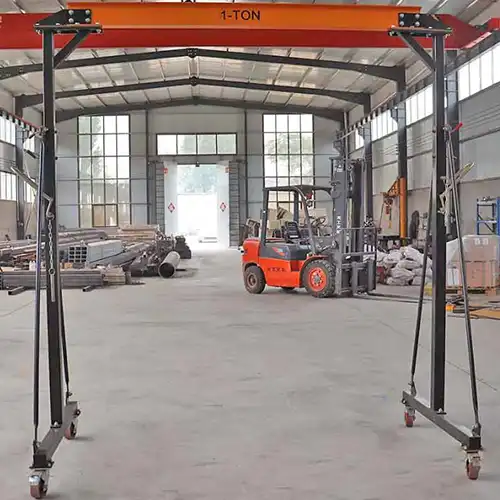
1 Ton A-Frame Hoist: Compact Solution for Light-Duty Work
Maintenance tasks, light equipment handling, small machine repair, laboratory work, and garage lifting.
Benefits: A 1-ton A-frame hoist is highly portable, easy to position, and simple to operate. Its compact size and lightweight design make it an excellent choice for tight or low-clearance areas where space is limited. Because of its lower cost and minimal setup, it's a practical solution for shops and sites with occasional or light lifting needs.
Limitations: While convenient, 1-ton models are not suitable for heavy industrial applications or frequent lifting of larger equipment. They are limited to lighter loads and may not withstand the wear and tear of continuous or high-capacity operations. If your work involves demanding tasks or harsh environments, a larger or more robust crane would be more appropriate.
Overview of 1 Ton A-Frame Crane Options:
- Manual A-Frame Hoist: Hand-operated with winch or chain block; best for low-frequency, small-load tasks.
- Electric A-Frame Hoist: Fitted with an electric hoist for smoother, repetitive lifting with reduced labor.
- Adjustable Span Models: Beam width can be modified to suit various load sizes and lifting positions.
- Foldable or Lightweight Designs: Easy to transport, set up, and store — ideal for mobile maintenance or site-to-site use.
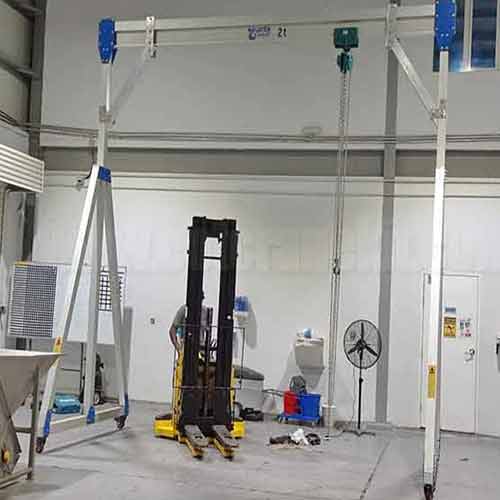
2 Ton A Frame Hoist / Gantry — Versatile Medium-Duty Option
- Use Cases: Workshop maintenance, assembly lines, medium-weight equipment handling.
- Balance: Offers a good mix of portability and lifting capacity suitable for small industrial environments.
- Industries Served: Manufacturing plants, repair shops, warehouses.
Overview of 2 Ton A-Frame Crane Options:: The 2 ton A-frame cranes strike a strong balance between portability and capacity, making them a popular choice for workshops and small factories. Available with wheels for easy mobility or adjustable heights for flexible operation, these models cover a wide range of medium-duty lifting tasks effectively.
- Basic 2 Ton A-Frame Hoist: Manual or electric hoists for moderate lifting.
- 2 Ton A-Frame Gantry with Wheels: Provides mobility inside workshops or on smooth floors.
- Adjustable Height Models: Accommodate variable lifting heights to fit different tasks.
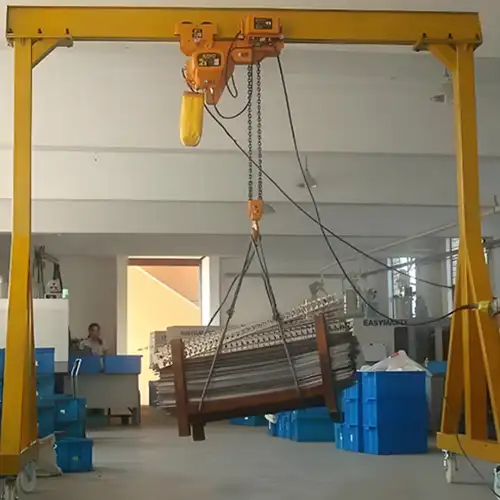
5 Ton A Frame Gantry Hoist / Crane — Heavy Workshop and Fabrication Work
- Applications: Lifting heavier machinery, loading/unloading, fabrication tasks requiring more frequent or larger lifts.
- Advantages: Stronger steel structures to withstand industrial workloads and repeated use.
- Typical Users: Metalworking shops, warehouses, medium-scale manufacturing.
Overview of 5 Ton A-Frame Crane Options:: For heavier lifting demands, 5 ton a frame cranes are designed with durability and strength in mind. These cranes are suitable for fabrication shops and warehouses where reliability and load capacity are critical. Options range from stationary heavy-duty gantries to portable models with electric hoists, enabling flexible deployment.
- Heavy-Duty Gantry Cranes: Built with thick steel for demanding workshop use.
- Portable Gantry with Electric Hoist: Combines power and moderate mobility for flexible site operations.
- Custom Span and Height Configurations: Tailored to client plant layouts or unique load sizes.
- Outdoor Rated Versions Aluminium Gantry Crane: With weatherproof coatings for moderate outdoor environments.
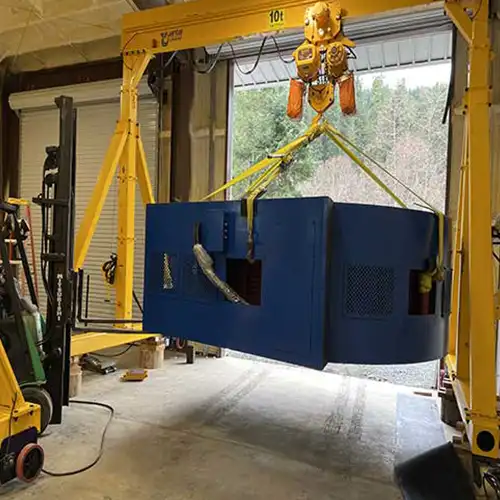
10 Ton A Frame Hoist — Heavy-Duty for Construction and Industrial Sites
- Typical Tasks: Construction yard lifting, heavy equipment positioning, outdoor or large industrial applications.
- Considerations: Larger size reduces portability, requires more setup space and time.
- Common Buyers: Construction companies, heavy equipment rental services, large industrial plants.
Overview of 10 Ton A-Frame Crane Options:: When heavy-duty lifting is required, 10 ton A-frame cranes deliver the necessary power and stability. These cranes are ideal for construction sites and heavy industrial operations, where robust fixed or modular designs are needed. Although less portable, they provide strong lifting capability and often include advanced features for safety and durability.
- Fixed Heavy-Duty A-Frame Cranes: Designed for stationary heavy lifting.
- Electric or Hydraulic Hoist Gantries: Provide strong lifting power and precise control.
- Modular or Demountable Designs: Can be assembled or disassembled for transport or expansion.
- Specialized Outdoor Models: Reinforced for harsh environments with anti-corrosion treatments.
How Capacity Affects Crane Size, Weight, Price, and Application
Selecting the right lifting capacity for your A-frame crane is about more than just the weight of the load. It impacts the crane's size, construction materials, total weight, mobility, and cost. Below is a breakdown of how capacity influences each factor.
Capacity vs. Size
As the crane's lifting capacity increases, its physical dimensions must also grow to maintain safety and structural strength. A stronger frame is required to handle the added force and load dynamics.
- Higher capacity requires a larger, stronger frame.: A 1-ton crane might use smaller I-beams and compact legs, while a 10-ton unit needs deeper beams, thicker columns, and stronger joints.
- Footprint increases with capacity.: Heavier cranes need wider spans and taller clearances, which means more workshop space is required for installation and safe operation.
Capacity vs. Weight
Stronger cranes require thicker steel components and reinforcements, which significantly increase the crane's total weight. This has a direct effect on portability and ground requirements.
- Steel thickness and structural reinforcements increase overall crane weight.: Lifting capacity multiplies the steel volume used; a 5-ton crane may weigh 3 to 5 times more than a 1-ton version.
- Heavier cranes require stronger casters or motorized travel.: Manual pushing becomes impractical above 2 or 3 tons unless supported by large industrial wheels or powered movement systems.
Capacity vs. Price
With greater load capacity comes higher engineering, material, and production costs. These affect not just the initial price, but sometimes also the delivery and setup costs.
- Higher capacity means higher material, machining, and transportation costs.: The transition from 2 tons to 5 tons usually involves not just more steel, but redesigned frames and upgraded load-bearing parts.
- Custom reinforcements increase cost.: Optional features like dual-beam designs, wider treads, and enhanced bracing can further raise the price.
Capacity vs. Usage
The right capacity should be chosen based on how and where the crane will be used. Different load capacities are better suited for different industries, environments, and lifting frequencies.
- Lower capacity (1–2 ton):: Great for occasional lifting in garages, labs, HVAC work, and light workshop use.
- Medium capacity (3–5 ton):: Suitable for regular lifting tasks such as equipment repair, small mold handling, and component transfers.
- Higher capacity (6–10 ton):: Designed for heavier-duty work like machine assembly, steel fabrication, and high-load transfer in industrial plants.
Safety Margin Tip
Always choose a crane that offers more capacity than your maximum lifting weight. This buffer ensures long-term performance, operator safety, and compliance with lifting standards.
Never size your crane exactly to your maximum load.: Always allow for a 10–20% safety margin.
- Example: Lifting 800 kg? Use a 1-ton crane.
- Handling up to 2.5 tons? Opt for a 3-ton or 3.2-ton model.
This margin:
- Prevents structural stress
- Enhances crane durability
- Reduces risk during uneven or dynamic loads
- Improves overall reliability
Practical Selection Tips for Crane Buyers
Choosing the right overhead crane involves balancing many factors beyond just lifting capacity. Understanding your specific needs, work environment, and budget will help you select a crane that performs reliably, safely, and efficiently over the long term. Below are key considerations to guide your decision.
- Assess Load Requirements: Know your maximum and typical lifting weights; add a safety margin (10-20%).
- Frequency of Use: Heavy frequent use favors electric or hydraulic hoists; occasional lifting may work with manual models.
- Mobility Needs: Wheeled or foldable gantries suit mobile jobs; fixed cranes suit static setups.
- Space Constraints: Adjustable spans and heights help cranes fit in limited or unusual spaces.
- Environment: Outdoor use requires weatherproof coatings and corrosion resistance.
- Budget vs Value: Cheaper cranes may save upfront but could increase downtime or maintenance costs.
- Certification and Safety: Confirm compliance with local standards (CE, ISO, OSHA).
In summary, investing time to assess these factors carefully will help you choose an overhead crane that fits your operational demands, enhances safety, and delivers dependable performance—saving you costs and headaches down the line.
Additional Features & Customization Options
Overhead cranes can be customized to better fit your unique operational requirements. Choosing the right features can improve efficiency, safety, and ease of use, making your investment more valuable and versatile. Consider the following common options when selecting or designing your crane:
- Adjustable Height and Span:: Cranes with adjustable leg height and beam span provide flexibility to handle various lifting tasks and fit different workspace dimensions.
- Hoist Types:: Depending on your lifting frequency and load, choose from manual, electric, or hydraulic hoists. Each offers different levels of control, power, and cost.
- Mobility Options:: Mobility can range from fixed legs for stability, wheels for easy repositioning, to foldable designs for convenient storage and transport.
- Safety Features:: Important safety components include overload protection to prevent overloading, limit switches to control travel range, and emergency stop buttons for immediate shutdown in hazards.
- Material Quality:: Selecting the appropriate material—such as carbon steel for general use, stainless steel for corrosion resistance, or coated steel for outdoor durability—can extend crane lifespan and reduce
Conclusion: How to Choose the Right A-Frame Crane
Selecting the right A-frame crane or gantry crane is crucial for safe and efficient lifting operations. It's not just about picking a crane capacity from a chart—it's about matching the crane's load capacity, size, and features to your actual lifting needs and workspace.
- Why Crane Capacity Matters: Choosing the correct crane capacity prevents safety risks caused by overloading and avoids wasting money on oversized cranes that don't fit your requirements. Use capacity guidelines and comparison tables to find the right match for your lifting weights and frequency.
- Review Detailed Specifications and Quotes:Always download the detailed crane specification sheets that include dimensions, power options, and material details. Comparing multiple quotes from trusted suppliers ensures you get the best price and features for your budget.
- Final Advice for Crane Buyers: Careful planning and research help you avoid costly mistakes. The right A-frame gantry crane or portable crane keeps your work running smoothly and safely, protecting your investment and improving productivity for years.
Frequently Asked Questions (FAQs) About A-Frame and Gantry Cranes
What is the difference between an A-frame crane and a gantry crane?
An A-frame crane features a rigid triangular frame and is often portable, designed for light to medium lifting tasks. In contrast, a gantry crane usually covers larger spans, can be fixed or mobile, and is built for heavier loads in bigger industrial spaces.
Can I upgrade a 1-ton A-frame crane later?
Some A-frame cranes offer limited upgrades like adjustable spans or stronger hoists. However, significant capacity increases usually require purchasing a new crane. Confirm upgrade options with your supplier before buying.
How portable are A-frame cranes in real-world use?
Portability depends on crane design:
- Hand-push portable cranes work well on smooth surfaces but are less effective on rough terrain.
- Foldable and lightweight cranes offer easy transport and setup for mobile jobs.
- Motorized traveling cranes provide powered movement but need adequate space and power sources.
What maintenance is required for A-frame and gantry cranes?
Regular crane maintenance is essential, including inspections of hoists, chains, brakes, and structural parts. Follow manufacturer guidelines for lubrication and promptly fix any wear or corrosion to avoid downtime and ensure safety.
Are 10-ton cranes safe for indoor use?
Yes, 10-ton indoor cranes can be used safely if the building structure supports the weight and the space meets height and clearance requirements. Check floor load capacity, ceiling height, and comply with safety regulations before installation.
Related Products
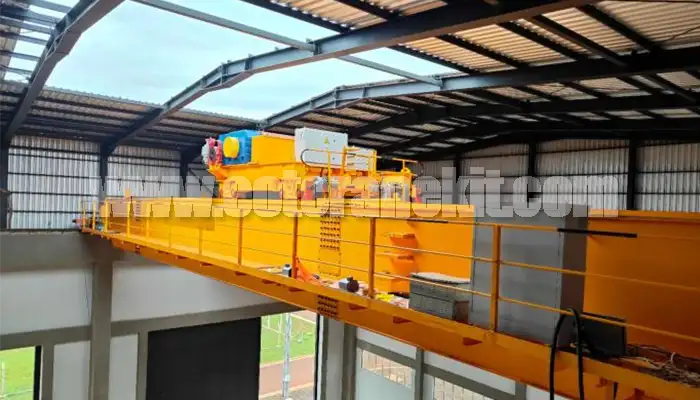
Latest project
150 Ton Overhead Crane Installation Feedback – Paraguay Case
QDX 150 ton overhead crane in action in Paraguay. Installation photos, video, and client feedback show performance, safety, and heavy-lifting efficiency.
Free consultation to Confirm Parameters & Specifications and Get
Latest Crane Price & Crane Rate.
- Types of overhead cranes : _______?
- Optional: Overhead travelling crane, goliath gantry crane,Slewing jib crane, Single girder or double girder crane,small portable crane or kbk crane, etc.
- Capacity of overhead crane: _______?
- Optional: 0.25ton, 0.5 ton, 1 ton, 2 ton, 3ton, 5 ton, 10 ton,15ton, 20ton, 25 ton, 30ton,35ton, up to 550ton, etc.
- Crane span & lifting height : _______?
- Crane travelling length : _____?
- Control of overhead crane:_______?
- Optional: pendant/ remote/cabin control
- Voltage supply of overhead crane:_____?
- Eg,: 380V50/60HZ,3Phase or others,etc.
- Application/usage of crane:_______?
- Eg,: Steel mill, ,injection mold, cement,stone, concrete,granite, general manufacturing, etc.
Just leave a message via the contact form and our hoist and crane engineer will contact you with in 24working hours.
Get In Touch

